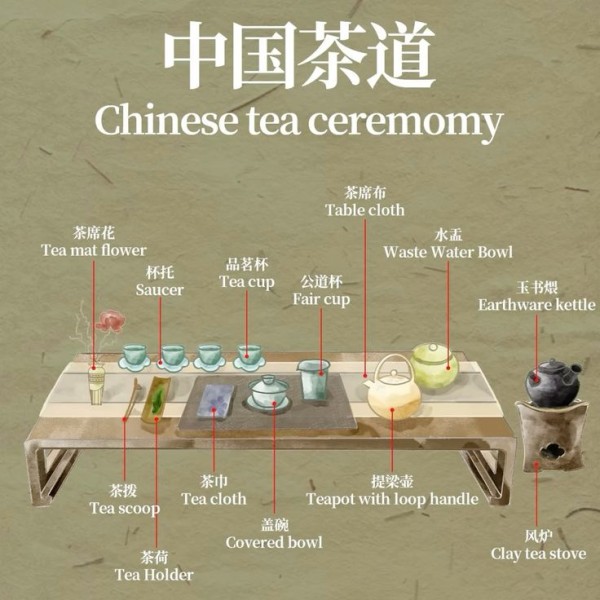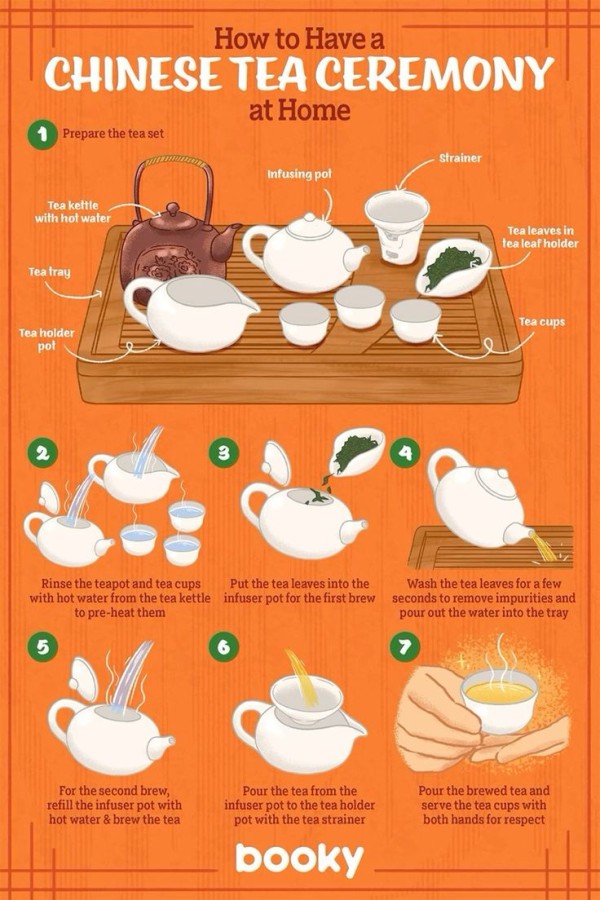Introduction
The Chinese tea ceremony, known as Gongfu Cha (工夫茶), is a refined cultural ritual that celebrates the art of brewing and enjoying tea. Rooted in thousands of years of Chinese history, it reflects philosophy, aesthetics, and social etiquette. Unlike a simple act of making tea, the Chinese tea ceremony is a meticulous process that emphasizes precision, mindfulness, and harmony between host, guests, and nature.
This comprehensive article delves deeply into the origins, cultural significance, detailed steps, utensils, types of tea used, and the spiritual and social essence of the Chinese tea ceremony. Whether you are a tea enthusiast, cultural scholar, or simply curious, this guide offers a rich understanding of one of China’s most treasured traditions.
1. Historical Background of the Chinese Tea Ceremony
Tea drinking in China dates back to at least the Tang dynasty (618–907 AD), with earlier mentions in the legendary accounts of Emperor Shennong over 4000 years ago. The formalized tea ceremony, however, took shape during the Song dynasty (960–1279 AD) and flourished in the Ming (1368–1644) and Qing (1644–1912) dynasties.
Tang Dynasty: Tea was consumed primarily as a medicinal beverage and social drink, often powdered and whisked.
Song Dynasty: Introduction of loose leaf brewing, porcelain teaware, and the rise of tea culture as an art form.
Ming and Qing Dynasties: Refinement of brewing techniques and development of Gongfu Cha, emphasizing skill and ceremony.
Over centuries, tea culture evolved from a utilitarian practice to a symbol of elegance, intellectual cultivation, and spiritual harmony.
2. Philosophical Foundations
The Chinese tea ceremony embodies key Chinese philosophies:
Daoism: Harmony with nature, simplicity, and naturalness are central. The ceremony encourages being present and attuned to the environment.
Confucianism: The tea ceremony expresses respect, hierarchy, and etiquette, fostering social harmony.
Buddhism: Mindfulness and meditative focus are cultivated during tea preparation and consumption.
The ceremony is not merely about tea but also about cultivating inner peace, social bonding, and aesthetic appreciation.
3. Essential Utensils of the Chinese Tea Ceremony
The tools used in the ceremony are carefully selected for function and beauty. A typical Gongfu tea set includes:
3.1 Tea Tray (Cha Pan)
A wooden or bamboo tray with a drainage system to catch spilled water or tea, keeping the space clean.
3.2 Teapot (Cha Hu)
Often a small Yixing clay teapot or porcelain pot, chosen for its heat retention and subtle influence on tea flavor.
3.3 Fairness Pitcher (Cha Hai)
A vessel used to pour tea from the teapot to ensure even distribution among cups.
3.4 Tea Cups (Cha Bei)
Small cups designed to appreciate tea aroma and flavor in small sips.
3.5 Tea Strainer (Cha Lou)
Placed over the fairness pitcher to catch tea leaves when pouring.
3.6 Tea Scoop (Cha Ze)
Used to transfer tea leaves from the container to the teapot.
3.7 Tea Tongs (Cha Jia)
Used for handling cups hygienically.
3.8 Kettle (Shui Hu)
To boil water, traditionally on charcoal or modern electric kettles.
3.9 Waste Water Bowl (Cha Hai or Cha Wan)
For discarding rinse water or the first infusion when rinsing leaves.
Each utensil contributes to the ceremony’s rhythm and ritual.

4. Selection of Tea for the Ceremony
The Chinese tea ceremony commonly features fine-quality teas with complex flavors suited for multiple infusions:
Oolong Tea: Famous varieties include Tie Guan Yin, Da Hong Pao, and Phoenix Dan Cong.
Pu-erh Tea: Aged, fermented tea from Yunnan, valued for depth and earthiness.
Green Tea: Such as Longjing (Dragon Well) for its fresh and vegetal notes.
White Tea: Delicate and subtle, like Bai Hao Yin Zhen (Silver Needle).
Black Tea: Typically traditional Chinese reds like Keemun or Lapsang Souchong.
The choice depends on regional preferences, season, and occasion.
5. Preparation Before the Ceremony
5.1 Setting the Space
The tea ceremony is often performed in a quiet, aesthetically pleasing environment, free from distractions, to foster mindfulness.
5.2 Heating Water
Water quality and temperature are critical. Spring or filtered water is preferred. Different teas require specific water temperatures, generally between 80°C to 100°C.
5.3 Preheating Utensils
Warming the teapot, cups, and fairness pitcher with hot water to maintain temperature consistency during brewing.
6. Step-by-Step Guide to the Chinese Tea Ceremony
The Gongfu Cha process is both art and science, designed to extract the best flavors from the tea.
Step 1: Measure Tea Leaves
Using the tea scoop, place an appropriate amount of tea (usually 5-7 grams) into the teapot, adjusted by teapot size.
Step 2: Rinse Tea Leaves
Pour hot water over the leaves and immediately discard this rinse water. This step awakens the tea and cleans dust from leaves.
Step 3: First Infusion
Add hot water again and steep for a short time (about 10-30 seconds depending on tea type). Pour the brewed tea into the fairness pitcher through the strainer, then distribute it evenly into cups.
Step 4: Tasting
Sip the tea slowly, appreciating aroma, flavor, and mouthfeel. Guests often use small sips to savor complexity.
Step 5: Subsequent Infusions
Repeat steeping multiple times, gradually increasing steep time. Quality tea leaves can yield 5-8 infusions or more.
Step 6: Clean Up
After the session, utensils are rinsed and dried carefully.
7. Etiquette and Social Aspects
The Chinese tea ceremony is a social ritual promoting respect and hospitality.
Serving Guests: Tea is served starting from the eldest or most honored guest.
Receiving Tea: Guests hold the cup with both hands as a sign of respect.
Tea Conversation: Conversation is typically calm, focusing on tea appreciation, nature, and philosophy.
Expressing Gratitude: Small gestures and words honor the host’s effort.
8. Cultural Significance
Tea ceremonies celebrate not just tea but relationships, nature, and tradition. They are common in family gatherings, business meetings, and cultural festivals.
Symbolism: Tea symbolizes purity, humility, and harmony.
Artistic Expression: Calligraphy, music, and flower arrangements often accompany the ceremony.
Spiritual Practice: For some, the ceremony is a form of meditation and self-cultivation.
9. Regional Variations
Different parts of China have distinct tea traditions.
Fujian and Guangdong: Emphasis on Oolong tea with elaborate Gongfu brewing.
Yunnan: Known for Pu-erh tea ceremonies.
Zhejiang: Green tea brewing with subtle rituals.
Sichuan and Chongqing: More casual tea culture with larger gatherings.
10. Modern Adaptations
While preserving tradition, modern practitioners sometimes blend contemporary aesthetics and technology, such as electric kettles or modern tea tables, making the ceremony accessible without losing its essence.
11. Health Benefits Associated with Chinese Tea Ceremony

Beyond cultural and spiritual, tea drinking offers many health benefits:
Rich in antioxidants
May aid digestion
Supports mental alertness
Promotes relaxation and stress relief
The slow, mindful nature of the ceremony enhances these effects.
12. Common Challenges and Tips for Beginners
Choosing quality tea: Start with reputable sources.
Mastering steeping times: Practice and adjust per tea type.
Patience: The ceremony requires time; rushing diminishes the experience.
Learning etiquette: Observe and emulate experienced practitioners.
Conclusion
The Chinese tea ceremony is a timeless blend of art, philosophy, and social grace. It transforms a simple beverage into a profound ritual that fosters mindfulness, connection, and appreciation of beauty. Understanding and practicing Gongfu Cha opens a window into Chinese culture and enriches the everyday experience of tea.
By embracing the ceremony, you don’t just drink tea—you participate in a heritage that has shaped civilizations and continues to inspire people worldwide.

